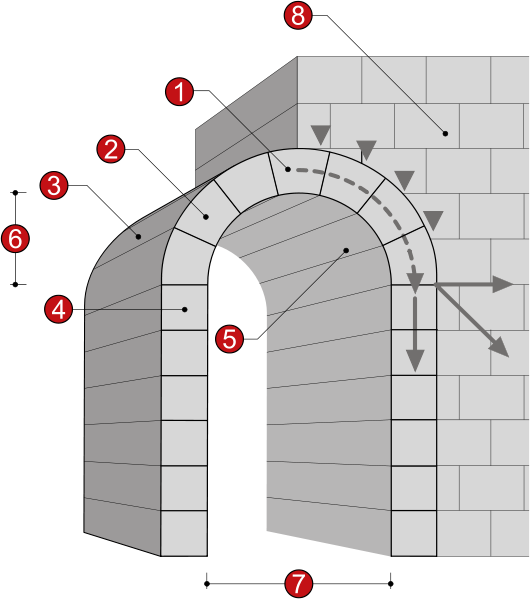I recently read a fascinating article by Santiago Huerta, a Spanish architect whose expertise lies in the structural analysis of arches and domes. (Galileo was Wrong! the Geometrical Design of Masonry Arches, Nexus Network Journal, Volume 8, No. 2, 2006).
Mr. Huerta describes how since antiquity, master masons have always used simple geometric rules involving proportions to design arches. For example, if an arch is a certain length (or span) it must be a certain thickness. It is a proportional design independent of scale. This method was developed before (and independent of) any formal scientific method. This system employed by ancient master masons has proven very effective, as demonstrated by the existence of numerous large masonry structures which have survived over millennia, as discussed several times earlier on this blog.
The proportional approach is a geometric approach: designs are scale able, an arch design which is 10 ft wide and one foot thick can also be made 30 feet wide and 3 feet thick. This approach was used for hundreds (even thousands) of years before it was questioned by Galileo.
In 1638 Galileo attacked this simple approach used by master masons in his work Discorsi e Dimostrazioni Matematiche intorno à due nuove sicenze Attenenti alla Mecanica & i movimenti Locali (Dialogues Concerning Two New Sciences). Here, for the first time, was an articulation of what has come to be known as the Square Cube Law.
Here is Galileo attacking the method of proportions in rumination on his research to his colleague, Giovanni Francesco Sagredo: “Therefore, Sagredo, you would do well to change the opinion which you, and perhaps also many other students of mechanics, have entertained concerning the ability of machines and structures to resist external disturbances, thinking that when they are built of the same material and maintain the same ratio between parts, they are able equally, or rather proportionally, to resist or yield to such external disturbances and blows. For we can demonstrate by geometry that the large machine is not proportionally stronger that the small. Finally we may say that, for every machine and structure, whether artificial or natural, there is set a necessary limit beyond which neither art nor nature can pass; it is here understood, of course, that the material is the same and the proportion preserved.”
Galileo was formally developing the notion that as a size increases, its surface area increases as a square, and its volume increases as a cube. He took these simple facts and applied them to design of structures. This same principal is evident in nature: the bone structure of a bird is not proportionally the same as that of an elephant. The elephant’s bones are much more massive than that of a bird; because the increase in scale is not linear, the volume is cubed. This can be extrapolated out to the scale of a dinosaur.
This all relates directly to masonry and scaling of structures. I will continue this discussion next time, and we will see that ultimately Galileo was wrong, and that the “ignorant” master masons of antiquity had it right.







No comments:
Post a Comment